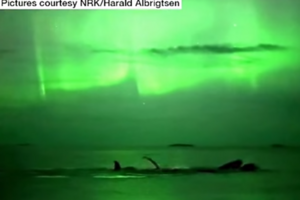Stunning video of humpback whales bathed in Northern Lights
Humpback whales just might be making a permanent return to Norwegian waters.

A group of humpback whales basking under the Northern Lights has been captured on camera by Norwegian TV.
The video was filmed off the coast of Kvaløya (Whale Island) near the city of Tromsø.
YouTube/NRK/Harald Albrigtsen
In a spectacular scene – and a visible sign of environmental progress – a group of humpback whales was filmed off the coast of Norway, leaping and playing under a dazzling display of northern lights.
The video was captured by Harald Albrigtsen, a photographer employed by the Norwegian Public Broadcasting (NRK), while he was testing some equipment, including a special camera capable of capturing footage in the dark without losing its image definition.
The video is emotionally stirring; it shows a group of approximately five or six humpbacks all playing together off the coast, located near the Norwegian city of Tromsø. The dazzling northern lights can be seen spinning overhead.
Kvaløya is a Norwegian word which translates to “whale island.” In an interview with Norwegian newspaper NRK, Albrigsten said that the experience of shooting the video was anything but ordinary.
“Catching [the] whales adventure and [the] northern lights adventure simultaneously is a dream for many,” he said.
Apart from the beauty of the moment, it chronicles the return of humpbacks in Norwegian waters, which only started three or four years ago. Most humpbacks swim directly from the Barents Sea to the Caribbean, a reason why humpbacks are so rarely observed in Norwegian waters.
“It’s a new phenomenon for them to be coming here to Tromsø. This is occurring to an extent which no living person has ever witnessed. It gives us a unique opportunity to chart the otherwise little known north-eastern stock of North Atlantic humpback whales,” Fredrik Broms, a conservationist, explained to the scientific magazine ScienceNordic.
The Marine Mammal Center reports that "there seem to be three distinct populations of Humpbacks that do not interact with one another: one in the North Pacific, one in the North Atlantic, and another in the Southern Hemisphere (south of the equator)."
Humpbacks were, until very recently, a vulnerable to extinction species. While they have not rebounded to their pre-whaling population of 125,000, the worldwide population currently stands at approximately 80,000, prompting the International Union for Conservation of Nature to move them in 2008 from "vulnerable" to "less threatened" with extinction.
As with other large whale species like the blue whale, run-ins with large fishing vessels remain one of the humpback’s primary threats. Killer whales are among humpbacks’ only natural predators, but the Norwegian Polar Institute, a conservation agency, reports that fatal attacks are primarily limited to juvenile humpbacks.
Conservation efforts to help the Norwegian whale population rebound are chiefly focused on tagging and tracking, in order to better understand their migration populations and record which whales are returning to the same part of the ocean each year. Fredrik Broms told ScienceNordic that as a result of his fledgling image-tracking system that records migrating Norwegian whales, he has recorded some 453 individual whales.
“I recognize steadily more of these individuals from one year to the next, thanks to [the] identifying markings on their flukes,” he said. “But we still don’t know much about the route taken by the humpbacks at the beginning of the year.”

